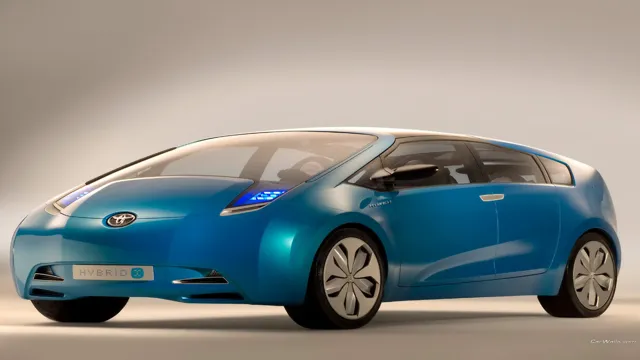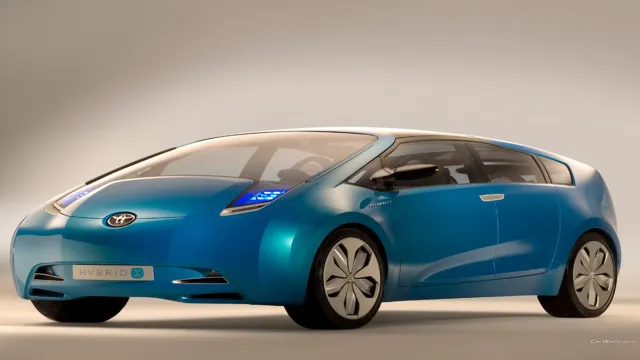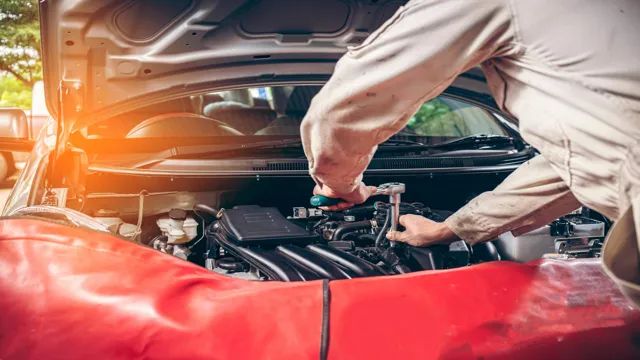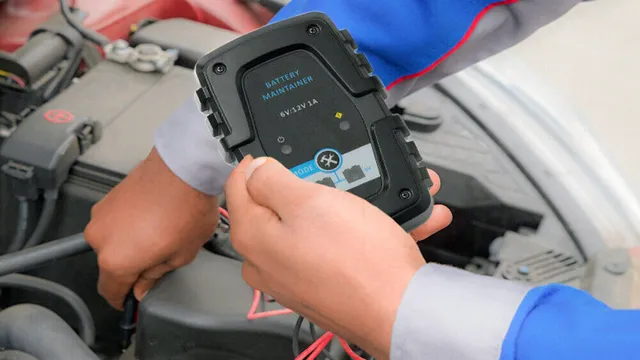Revolutionizing Auto Maintenance: Why Electric Cars are Cheaper and Easier to Maintain
Are you tired of spending thousands of dollars every year on car maintenance? Do you dread the hassle of routine visits to the mechanic? If so, you may want to consider making the switch to an electric car. These innovative vehicles require significantly less maintenance than their gas-guzzling counterparts, making them a practical and cost-effective option for any driver. When it comes to maintaining an electric car, the process is much simpler and straightforward.
Unlike traditional cars, electric vehicles have fewer moving parts, which means that there are fewer components that can break or wear out over time. Furthermore, electric cars don’t require oil changes, transmission replacements, or spark plug replacements, which means that you’ll save hundreds (if not thousands) of dollars each year on routine maintenance. Of course, that’s not to say that electric cars are immune to wear and tear.
Like any vehicle, they still require regular upkeep to ensure optimal performance. However, electric car maintenance is typically limited to brake pad replacements, tire rotations, and occasional software updates. The result is a driving experience that’s cleaner, more convenient, and much easier on your wallet.
So if you’re looking for a cost-effective, low-maintenance vehicle that’s good for the environment, an electric car may be just what you need. Not only do these vehicles offer a more sustainable way to get around, but they’re also much easier (and cheaper) to maintain than traditional vehicles. Who knows? Making the switch to an electric car might just be the best decision you’ve ever made.
Less Time Spent on Regular Maintenance
When it comes to regular car maintenance, electric vehicles (EVs) have a significant advantage over their gasoline-powered counterparts. One key factor is the number of parts that make up an EV. Compared to traditional cars that have hundreds of mechanical components, EVs have far fewer parts that can malfunction, like engines, transmissions, and radiators.
Additionally, EVs do not require oil changes or spark plugs to be replaced, as they don’t have an internal combustion engine. This means less time spent on routine maintenance, less money spent on replacement parts, and fewer trips to the mechanic. In fact, some EV models have maintenance schedules that are as simple as rotating the tires and replacing cabin air filters.
Overall, owning an electric car can save time, money, and hassle when it comes to maintenance and repairs.
Battery Maintenance is Minimal
If you’re concerned about battery maintenance being a time-consuming task, then rest easy! Today’s batteries are designed to require minimal maintenance, so you can spend your time doing other things. In fact, modern batteries are designed to last longer with little attention, so you don’t have to spend your time checking fluid levels, looking for leaks, or dealing with corrosion. The keyword to remember is “maintenance-free.
” This means that you don’t have to do much except keep an eye on things and ensure your battery is connected properly. Think of it as having a self-sustaining garden that only needs occasional watering – and won’t wilt if you forget about it for a few days. Gone are the days of having to add water, test voltage, and clean terminals.
A modern battery is an investment that just keeps paying off, and with less time spent on battery maintenance, you’ll have more time to enjoy your car, boat, or RV.

Fewer Moving Parts to Repair
One of the biggest benefits of having fewer moving parts in your machinery is that you’ll spend less time on regular maintenance. With fewer parts to check and repair, you can focus your attention on other important tasks like growing your business or spending time with family. This is especially true for small business owners who don’t have a dedicated maintenance team and need to balance their workload with other responsibilities.
By investing in equipment with fewer moving parts, you can reduce your overall workload and increase your productivity. Think of it like driving a car with a simple engine versus a complex one – the more parts there are, the more likely something will go wrong. But with a simpler design, you can spend less time under the hood and more time on the road.
So if you’re looking to streamline your business operations and reduce the time you spend on maintenance, consider investing in equipment with fewer moving parts. Your workload – and your sanity – will thank you for it!
Cost Savings on Maintenance
One of the key advantages of electric cars is their lower maintenance costs compared to traditional gasoline-powered vehicles. Because electric cars have fewer moving parts, there are simply fewer things that can go wrong. For example, electric cars don’t require oil changes, and their brakes tend to last longer because regenerative braking systems capture much of the kinetic energy that would normally be lost and use it to recharge the battery.
Additionally, since electric cars don’t have a traditional engine or transmission, they avoid many of the issues that come with those complex systems, such as spark plug replacements and transmission fluid changes. Keeping an electric car in good working order is also typically easier due to the fact that electric cars can often be serviced remotely using software, reducing the need for in-person visits to the mechanic. Overall, the simplified design and reduced complexity of electric cars means that drivers can save considerably on maintenance costs over the life of the vehicle.
Lower Cost of Maintenance
When it comes to maintaining any product, it can be both costly and time-consuming. However, when it comes to technology, the cost of maintenance can be a significant burden for businesses, especially those that rely heavily on computer systems. Fortunately, with the advancement of technology, maintenance costs have decreased, providing businesses with substantial cost savings.
By implementing low-cost tools to manage and maintain technology, companies can reap the benefits of reducing their maintenance expenses. These low-cost tools can include automated software updates, remote management and monitoring, and cloud-based software solutions. By allowing these tools to perform routine maintenance, businesses can ensure that their technology stays up-to-date and running smoothly without the added cost of hiring IT staff to perform manual updates and repairs.
In addition, with fewer maintenance-related issues, companies can focus their attention on other critical areas of their business. In summary, lower maintenance costs through the use of technological advancements can be a key factor in helping businesses save money and improve overall productivity.
Fewer Parts to Replace and Repair
When it comes to operating heavy machinery, maintenance costs can be a significant burden on any company’s bottom line. Fortunately, by investing in equipment with fewer replaceable parts, companies can save money on maintenance. Machines with fewer parts may cost more initially, but the investment pays off over time.
With fewer parts to maintain, there is less need for ongoing repairs, which frees up time and resources for other tasks. Plus, the quality of the equipment is often higher when there are fewer parts, leading to less wear and tear overall. In the long run, investing in equipment with fewer replaceable parts can save businesses both time and money, leading to greater profits.
So, when considering new equipment, it may be worth looking into machines with fewer parts to enhance cost savings and improve overall efficiency.
Cheaper Fuel Costs
One of the biggest advantages of implementing cheaper fuel options in vehicles is the significant cost savings on maintenance. By switching to fuels like ethanol or natural gas, car owners can save money on oil changes, air filter replacements, and other regular maintenance services that come with traditional gasoline-powered engines. Cheaper fuel options also have the potential to reduce wear and tear on engine parts, ultimately prolonging the lifespan of a vehicle.
Not only do these lower maintenance costs benefit individual car owners, but they also have the potential to save businesses and government agencies substantial amounts of money in fleet maintenance expenses. Overall, the switch to cheaper and more sustainable fuel sources not only benefits the environment but also provides a practical solution for cost-conscious car owners and businesses alike.
Increased Lifespan of Parts
One of the main advantages of electric cars over traditional gas-powered cars is their increased lifespan of parts. This is because electric cars have far fewer moving parts compared to a gas-powered car, which means less wear and tear on those parts. For instance, there is no need for an oil change in an electric car, as there is no oil to change.
Additionally, electric motors are much simpler than gas engines; they have only one moving part, which results in fewer components that can break down or require maintenance. This makes electric cars much more reliable and less likely to break down. Furthermore, since electric cars require less maintenance, the cost of upkeep is also lower, thus saving you money in the long run.
Overall, it’s clear that electric cars are easier to maintain than traditional gas-powered cars, making them an attractive option for those looking for a low-maintenance and more sustainable ride.
Less Wear and Tear on Engine
When it comes to maintaining the health and longevity of your vehicle, the wear and tear on the engine is a critical factor to consider. One way to increase the lifespan of parts in your engine is by utilizing high-quality lubricants and oils. By doing so, you reduce the friction between moving parts, preventing premature damage and wear.
Regularly changing the oil and using the right type for your car also helps keep your engine running at its optimal level, effectively extending its lifespan. Failing to take proper care of your engine can lead to costly repairs, or even worse, the complete breakdown of your vehicle. So, next time you’re due for an oil change, consider using a top-quality lubricant to help reduce wear and tear on your engine and increase the lifespan of its parts.
Your car will thank you for it!
Higher-Quality Brakes and Tires
When it comes to vehicle maintenance, investing in higher-quality brakes and tires can significantly increase the lifespan of these crucial parts. While it may be tempting to opt for cheaper, budget-friendly options, it’s important to remember that inferior parts not only wear out more quickly, but also pose a risk to safety. High-quality brakes and tires are crafted with durable materials and are designed to perform under intense pressure and high speeds.
Think of it like buying a sturdy pair of hiking boots – an initial investment may cost more upfront, but the long-term benefits are well worth it. Upgrading your brakes and tires can not only increase the lifespan of these parts but also provide peace of mind that you and your passengers are safe on the road.
Fewer Environmental Concerns and Regulations
Maintenance of electric cars is much easier and environmentally friendly than traditional gas-powered cars due to fewer environmental concerns and regulations. Electric cars produce no emissions while driving, meaning there is no need for oil changes or exhaust maintenance. Additionally, electric cars have fewer moving parts than combustion engines, which require less maintenance overall.
Another benefit is that electric cars can often be charged at home, eliminating the need for regular visits to gas stations. Furthermore, electric cars face fewer regulatory barriers, such as emissions and noise regulations, compared to gas-powered cars, which can lead to reduced maintenance costs. Overall, electric cars are a more convenient option for maintenance due to their simpler design and ease of charging, making them a more attractive option for those looking to make the switch from traditional gas-powered vehicles.
Conclusion
In summary, owning an electric car is like having a high-tech pet that requires very little upkeep. Imagine not having to change your oil, replace your spark plugs, or worry about typical engine malfunctions. With fewer moving parts and a simpler design, electric cars offer a maintenance experience that is not only easier but also more eco-friendly.
So, whether you’re an environmentally-conscious driver or simply looking for a hassle-free ride, an electric vehicle is the way to go.”
FAQs
What maintenance tasks are required for electric cars?
While electric cars require some basic maintenance tasks like tire rotations and brake pad replacements, they require less maintenance than traditional cars because they have fewer moving parts and no oil changes are needed.
How often should I have my electric car serviced?
Most electric car manufacturers recommend having your vehicle serviced every 12,000 to 15,000 miles or once a year, whichever comes first.
Can I maintain my electric car on my own, or do I need a professional?
Some basic maintenance tasks for electric cars can be done at home, like checking tire pressure and topping off washer fluid. However, more complex tasks like battery maintenance and repair should be left to a professional.
Do electric cars have fewer maintenance costs than traditional cars?
Yes, electric cars generally have lower maintenance costs than traditional cars. With fewer moving parts, no oil changes needed, and regenerative braking extending brake life, the overall maintenance cost of electric cars is significantly lower.






